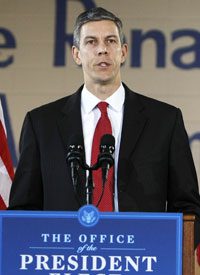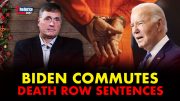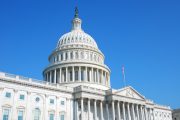
Among the facts known about Duncan are that he routinely plays basketball with Obama and, just like Obama, he is a graduate of Harvard. But little else is known of him other than the rhetoric that he works to “transform” schools.
"When it comes to school reform, Arne is the most hands-on of hands-on practitioners," Obama said. "For Arne, school reform isn’t just a theory in a book — it’s the cause of his life. When faced with tough decisions, Arne doesn’t blink. He’s not beholden to any one ideology — and he doesn’t hesitate for one minute to do what needs to be done."
The Washington Post reported: “Duncan is embraced by the teachers unions, who have been concerned about high-stakes testing and worry about merit pay being tied to test scores, as well as reformers, who favor charter schools and tougher standards.”
“He represents a compromise choice in the debate that has divided Democrats in recent months over the proper course for public-school policy after the Bush years,” says the New York Times.
Catalyst Chicago, which describes itself as an independent newsmagazine that focuses on school reform, notes that little has changed in Chicago under Duncan’s leadership.
High school graduation rates improved, as did college entrance rates. But, fewer than one third of those who entered actually graduated from college, which is the real litmus test.
One improvement noted was the district’s accountability, making sure students go to college. Duncan created the Office of Post-secondary Education and charged it with tracking students after they graduate. Duncan personally pushed principals to get more students to fill out financial aid eligibility forms. But succes in filling out forms does not equate to academic improvement.
Test scores, often viewed as a real measure of improvement, remain stagnant district wide — only 31 percent of juniors meet state standards. All but two of the 10 lowest performing high schools in 2001 lost ground by 2008. Definitely no improvement there.
Duncan has used three strategies to help transform Chicago schools: Close them down and replace them with new, smaller schools (Renaissance 2010); fire school staff and reopen under new management (turnaround strategy); or infuse classrooms with new curriculum and materials (High School Transformation). This has been expensive.
Presently, 50 schools are participating in the High School Transformation program alone at a cost of $80 million. But implementation has not been smooth. Catalyst reported that hundreds of students in the city’s worst high schools showed up weeks after the school year began. On average, students in these schools were absent 50 days or more. The one tool schools used to combat it with — truancy officers — are long gone.
Duncan has opened 75 new schools under Renaissance 2010. A Catalyst analysis found that of the students who were displaced by school closings, only 2 percent were enrolled the next fall in new Renaissance schools. Nearly half of the displaced students landed at schools that were already on academic probation.
Performance-based teaching encouraged by Duncan rewards well-run schools and teachers but has seen decision-making powers of the individual schools greatly reduced, even to the point where an individual school’s board cannot hire or fire it’s own principal. This trend does not bode well for the already unconstitutional Education Department under which federal control of local schools has increased over the decades.
Catalyst says, “President-elect Barack Obama has promised more responsive and transparent governance of the country. Duncan did the same when he took over, promising to flood schools with data for them to make better decisions.” But they found little evidence of any true transparency.



